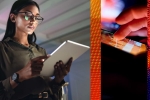
It’s time to look disruption in the eye
Setting the scene
The world is at an inflexion point, economically, politically and socially. The future is to be made. We can see the effects all around us. We know that these shifts – and the collisions between them – are reshaping societies, economies and behavioural norms across the world at a headlong pace. We also know that technology is the core driver of many of these impacts – from Artificial Intelligence (AI) to Augmented Reality, Virtual Reality, to 3D printing, and from autonomous cars, to CRISPR (stem cell rejuvenation), to drones – and that their combined effect is creating unprecedented pathways for societies, governments and businesses. What is more uncertain is how we should be planning for what’s to come.
To come up with an effective answer, organisations must be ready to stretch their horizons, and to move beyond their ‘official future’. The complexity of doing all this makes it tempting to focus on short term business planning. With so much hype, so many unknowns, and such a degree of volatility in every dimension, defining a strategic response can feel like an uphill struggle. But it needn’t be this way. There are actions our clients can take today to look ahead and futureproof their business – whatever that future may look like.
“How do we create a strategy for a business when the past is no longer a reasonable guide to the future?"
How we helped
Understanding the impact of disruptions on a business model is fundamental. So is gaining the capability to monitor and interpret the weak signals of forthcoming disruptive impacts. What we do is help organisations use these insights to tackle unforeseen, structural challenges with truly innovative thinking. At PwC, we’ve been undertaking this journey ourselves: extensively analysing disruptors and emerging technologies, through the lenses of the sectors where we understand what is changing our clients’ businesses. We’ve created a series of tools – including a Virtual Reality world and a weak signal monitoring capability – to help spot, understand and monitor the threats, opportunities and potential ‘Black Swans’ that are on the horizon. And we’ve imagined four scenarios for the world’s future, each setting out a very different trajectory for our clients, based on the levels of centralisation and innovation the future will bring.
Making a difference
We’ve developed a weak signal monitoring capability that scans the horizon for those weak signals of coming disruption that are hardest to detect. Our disruption and emerging tech team help create a risk radar and map the new landscape of risk and opportunity presented by emerging technologies.
We’ve also created a unique Virtual Reality world that allows you to step into one vision of the world in 2030. It gives you a vivid, first-hand experience of the world as it will be, stimulating a richer and more strategic conversation about specific disruptions on your organization.
Our research tracks over 150 different technologies, and we’ve applied our Emerging Tech Focus approach to pinpoint the 'Essential Eight’ technologies likely to have the biggest impact in the coming five years. ‘The eight emerging technologies you should learn to love’.
Some examples of our work include:
Transport
We have brought transport clients and industry experts together to visualise the future mobility ecosystem and understand where their fiercest and most unexpected competitors might come from. We help them think beyond today’s constraints and explore the possibilities to adapt and future proof their business.
Cities
We looked at cities across the globe, examining the most potent technological and social disruptions that might make them flourish or decline over the coming decades. We project the impact of combinations of risks and opportunities against our different scenarios, collaborating with clients to develop blueprints for more liveable, resilient and smarter cities.
Local public services
We have worked with frontline providers of local public services to help them harness emerging technologies: artificial intelligence in municipal services, drones in planning, maintenance and emergency services support, and analysing big data that reimagines how better to meet the needs of high dependency citizens.









